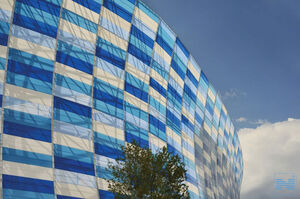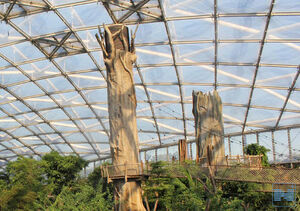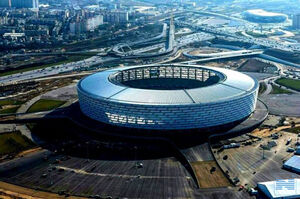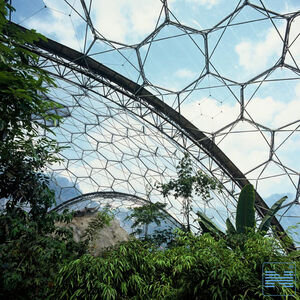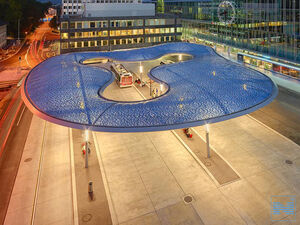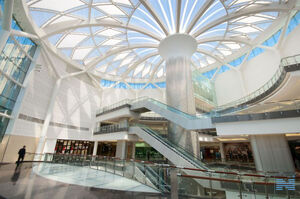ETFE in architecture: The future of roof and facade construction
ETFE is the material of the future. There are many reasons for this: It is a hundred times lighter than glass, yet extremely resistant, highly durable and fully recyclable. It also allows transmission of almost the entire UV spectrum and is incredibly versatile in use.
There are already some impressive examples of modern architecture featuring imposing ETFE facades and roofs. Here you can find a small collection of projects involving ETFE on buildings like greenhouses, stadiums and more:
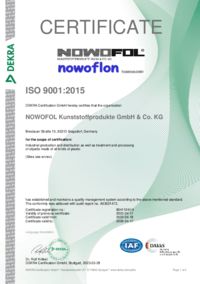
Would you like to learn more about the possibilities of ETFE in architecture? Contact us now.
Major projects with ETFE in architecture
ETFE in stadium: Estadio Cuauhtemoc, Pueblo Mexico
The stadium of the Mexican top division club FC Puebla has achieved a place in the Guinness Book of Records. It shines in the world's largest mosaic facade, which was constructed using more than 30,000 square meters of ETFE foil. This project highlights the benefit of ETFE’s light weight, as a glass construction would have required 1,500 tons more steel. This meant a weight saving of 60 percent.
The Estadio Cuauhtémoc has a height of 40 meters and is located in Heroica Puebla de Zaragoza, about 130 kilometers south of Mexico City. In 2014/2015, the building was comprehensively modernized and equipped with an ETFE facade system. The mosaic cladding in blue and white uses the club colors as the basis for a pre-Columbian design.
The region’s hot and humid climate required a very resistant material. That's where NOWOFLON ET 6235 Z-C came in. It does not contain any plasticizers that would evaporate in the climate and therefore does not provide a point of attack for algae or fungal growth. In addition, the films clean themselves via the lotus effect, meaning that minimal maintenance work is required over a very long service life.
ETFE in greenhouse: Zoo Gondwanaland, Leipzig, GER
Gondwanaland is a zoo in Leipzig housing around 500 tropical plant species and 140 animal species across 16,500 square meters. The greenhouse features a roof made from NOWOFLON ET 6235 Z that lets as much UV light as possible through. This ensures a comfortable environment for the plants and animals.
The roof and the upper side walls use transparent three-layer ETFE cushions. Thanks to its extremely low weight per unit area and high UV transmission of up to 95 percent, ETFE is ideal for greenhouses. The UV transmittance means that the zoo has no need for artificial lighting.
The ETFE greenhouse film offers good thermal insulation. The heat generated during the day is collected in geothermal energy storage and is used to heat the tropical zoo at night. It can also be used to heat the water and pools for the animals. Last but not least, the ETFE cushions are also an aesthetically pleasing option for roof construction, creating a building that looks like a sculpture made of ETFE windows.
The expansion and conversion of the zoo will help make Leipzig Zoo one of the most modern and innovative zoos in the world.
ETFE in stadium: Olympic Stadium Baku
The Olympic Stadium in Baku, Azerbaijan was built using ETFE. The entire facade and roof were clad with ETFE foil cushions for a unique appearance.
The ETFE-clad stadium was built for 69,000 visitors. It features six levels and is 60 meters high. With 62,000 square meters of ETFE foil, the stadium is a remarkable large-scale project. The ETFE cushions have to withstand high wind and weather loads, which is why the decision was made in favor of two-layer cushions of NOWOFLON ET 6235 Z-C. A total of 34,000 square meters of ETFE foil cushions were installed on the roof and 27,000 square meters on the facade.
The ETFE cushions were specially printed to control the radiation of the sun. Stainless steel cables on the inside of the foil reinforce the ETFE architecture and provide additional protection against wind. In addition to the optical sophistication, the sustainability of the ETFE stadium is also impressive, as the foil cushions are completely recyclable after decades of use.
ETFE in greenhouse: Eden Project, Cornwall, UK
The Eden Project in Cornwall perfectly shows how suitable ETFE is for greenhouses. The botanical garden is about 50 hectares in size and has become famous for the two largest greenhouses in the world. Both are covered by four geodesic domes, each with ETFE foils. Around 100,000 plants and 5,000 species are housed under the ETFE architecture.
This enormous dome required a lightweight material that allowed as much UV light to pass through as possible. This is why NOWOFLON ET 6235 Z was chosen. The enormous deformability and span width of ETFE films make it possible to choose lighter designs, as the components of the primary supporting structure do not have to be so rigid. With a weight of 667 metric tons, the structure of the Eden Project is considerably lighter than a comparable glass structure.
The translucent ETFE foil cushions protect the plants from the weather and allow the solar heat to be stored and used. The ETFE greenhouse therefore creates considerable synergies. The comb structure, which is only possible with ETFE, creates an unmistakable design that turns a building into functional art.
A whole roof made from only one ETFE cushion: bus station in Aarau, Switzerland
ETFE is not only suitable for big projects like stadiums. Smaller projects are no less impressive. The entire roof of this bus station in Aarau, Switzerland was created from just one ETFE foil cushion - affectionately called a "cloud" by the locals. It shows how versatile ETFE can be in architecture.
The cushion is supported by an irregular network of steel ropes that adapts to the design. The building material had to be able to withstand large amounts of snow and water, which is why NOWOFLON ET 6235 Z was used. The operating costs for the supporting air supply are less than one euro per year per square meter. The project saw 1,055 square meters of ETFE used, resulting in a design that makes the bus station unmistakable.
Would you like to see more examples for the use of ETFE in architecture?
Learn more about our Key References.
What do experts have to say about ETFE foil?

Stefan Behnisch - Architect
"We were looking for a material to form the outer film for a double facade. Single-layer ETFE was perfect. It is lightweight, innovative and visually attractive thanks to the high-tech look of the back span. The use of ETFE was also ideal from a fireproofing standpoint. ETFE is very transparent and almost impossible to tear when used in single-layer applications. The film is structurally stable and extremely durable. It’s easy to keep clean thanks to the “lotus effect” and offers an excellent cost-benefit ratio."

Florian Weininger - Engineer
"The quality of our planning and structural calculations depends on the material properties we take into consideration. The high quality of NOWOFLON products and the professional consultation with their staff helps us ensure that our clients really get what we promise in our planning."
Why does ETFE in architecture perform so well?
ETFE foil is extruded from granulates into sheets with incredibly high strength given the thickness of the material. Referred to as either foil or film, extruded ETFE is one of the most lightweight cladding materials that an architect can use. However, its transparency also allows for a great deal of creativity. The product’s low friction coefficient means that dust or small debris will not stick to the surface of the material, resulting in low maintenance requirements. In addition, the ETFE’s transparency prevents it from discoloring. Since UV light passes through it, discoloring and weakening over time from exposure to sunlight is not a problem. Another important aspect of the material is that ETFE can also be easily taken down and recycled, if required.
Originally developed by DuPont over four decades ago, ETFE was nothing more than an inert coating material and thought of as only of use to the aerospace industry. Once ETFE film was developed, the material was then used in several agricultural applications. Following its use in greenhouses, the material demonstrated its suitability for construction and ETFE architecture was truly born. It has also been used as a coating for solar cells, another architectural use for which it has come in handy.
Would you like to learn more about the use of ETFE in architecture?
Become an example of a successful ETFE project yourself and let’s talk about what is possible. Contact us now!


